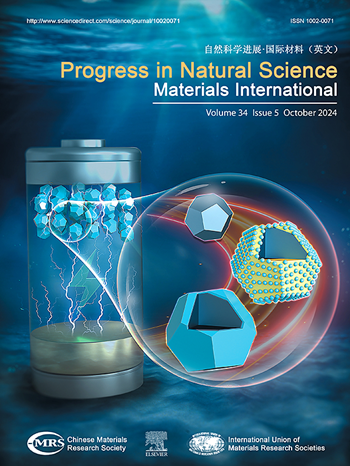The well-designed wollastonite-ZnIn2S4 composite photocatalysts for efficient hydrogen production
IF 7.1
2区 材料科学
Q2 MATERIALS SCIENCE, MULTIDISCIPLINARY
Progress in Natural Science: Materials International
Pub Date : 2025-04-01
DOI:10.1016/j.pnsc.2024.12.008
引用次数: 0
Abstract
A sustainable pathway to green hydrogen generation, the design and synthesis of targeted photocatalysts based on semiconductors or other organic/inorganic materials has emerged as a promising approach for efficient hydrogen production under light irradiation. In this paper, wollastonite-ZnIn2S4 composite photocatalysts (ZIS-W) were successfully prepared by the chemical deposition method with wollastonite as the carrier. The hydrogen evolution reaction from water under simulated sunlight irradiation and the enhancement mechanism of ZIS-W were investigated. The results showed that ZIS-W exhibits favorable photocatalytic hydrogen evolution performance and stability, and the photocatalytic hydrogen evolution efficiency of ZIS-W was 4.94 mmol h−1 g−1, which was 1.44 times higher than that of pure ZnIn2S4. The unique crystal structure of wollastonite provides favorable conditions for the growth of ZnIn2S4 and effectively enhances the dispersion and stability of ZnIn2S4. The recombination of photogenerated electron-hole pairs was effectively suppressed while the specific surface area was increased. This study provided a facile synthesis method for preparing photocatalysts with highly efficient hydrogen generation.
精心设计的硅灰石- znin2s4复合光催化剂用于高效制氢
设计和合成基于半导体或其他有机/无机材料的目标光催化剂是实现绿色制氢的可持续途径,这是一种在光照射下高效制氢的有前途的方法。以硅灰石为载体,采用化学沉积法制备了硅灰石- znin2s4复合光催化剂(ZIS-W)。研究了模拟日光照射下水的析氢反应及ZIS-W的增强机理。结果表明,ZIS-W具有良好的光催化析氢性能和稳定性,其光催化析氢效率为4.94 mmol h−1 g−1,是纯ZnIn2S4的1.44倍。硅灰石独特的晶体结构为ZnIn2S4的生长提供了有利条件,有效提高了ZnIn2S4的分散性和稳定性。在增加比表面积的同时,有效地抑制了光生电子-空穴对的复合。本研究为制备高效产氢光催化剂提供了一种简便的合成方法。
本文章由计算机程序翻译,如有差异,请以英文原文为准。
求助全文
约1分钟内获得全文
求助全文
来源期刊
CiteScore
8.60
自引率
2.10%
发文量
2812
审稿时长
49 days
期刊介绍:
Progress in Natural Science: Materials International provides scientists and engineers throughout the world with a central vehicle for the exchange and dissemination of basic theoretical studies and applied research of advanced materials. The emphasis is placed on original research, both analytical and experimental, which is of permanent interest to engineers and scientists, covering all aspects of new materials and technologies, such as, energy and environmental materials; advanced structural materials; advanced transportation materials, functional and electronic materials; nano-scale and amorphous materials; health and biological materials; materials modeling and simulation; materials characterization; and so on. The latest research achievements and innovative papers in basic theoretical studies and applied research of material science will be carefully selected and promptly reported. Thus, the aim of this Journal is to serve the global materials science and technology community with the latest research findings.
As a service to readers, an international bibliography of recent publications in advanced materials is published bimonthly.

 求助内容:
求助内容: 应助结果提醒方式:
应助结果提醒方式:


